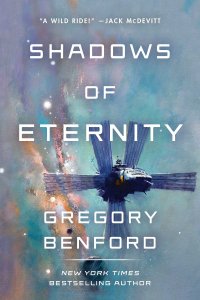Gary K. Wolfe reviews M. John Harrison
 No other author I can think of can write with such elegant precision about indeterminacy, or with such purposefulness about purposelessness, as M. John Harrison. Throughout his new novel Empty Space: A Haunting – the third volume in his Kefahuchi Tract sequence that began with Light in 2002 and continued with Nova Swing in 2006 – we’re reminded that characters ‘‘had no idea where the first jump would take them,’’ that ‘‘she had remembered everything but it meant nothing,’’ that though ‘‘the entire human race soon knew how to find its way around, it still had no idea where it was.’’ And this is true not only of the characters living in the far-future city of Saudade, the rather seedy noir setting that we first encountered in Nova Swing. After all, they’ve got an excuse of sorts: a portion of the mysterious Kefahuchi Tract, that unruly abscess in space-time in which almost anything can happen and causality is little more than a suggestion (and which we first encountered in Light) has gone to ground nearby, resulting in a flurry of tourism, crime, and smuggling, often involving inexplicable artifacts from the ‘‘zone.’’ But Harrison’s near-future characters, haunted by the dead and by each other, don’t fare much better despite living in a far more recognizable setting. Almost no one in a Harrison novel knows where they’re supposed to be, and a good many can’t even figure out where they are. And many, both present and future, are puzzled by a tantalizing disembodied voice announcing, ‘‘My name is Pearlant and I come from the future.’’ It’s only one of a number of classic narrative hooks that keep drawing you into the complexities of Empty Space, but it may be the most effective.
No other author I can think of can write with such elegant precision about indeterminacy, or with such purposefulness about purposelessness, as M. John Harrison. Throughout his new novel Empty Space: A Haunting – the third volume in his Kefahuchi Tract sequence that began with Light in 2002 and continued with Nova Swing in 2006 – we’re reminded that characters ‘‘had no idea where the first jump would take them,’’ that ‘‘she had remembered everything but it meant nothing,’’ that though ‘‘the entire human race soon knew how to find its way around, it still had no idea where it was.’’ And this is true not only of the characters living in the far-future city of Saudade, the rather seedy noir setting that we first encountered in Nova Swing. After all, they’ve got an excuse of sorts: a portion of the mysterious Kefahuchi Tract, that unruly abscess in space-time in which almost anything can happen and causality is little more than a suggestion (and which we first encountered in Light) has gone to ground nearby, resulting in a flurry of tourism, crime, and smuggling, often involving inexplicable artifacts from the ‘‘zone.’’ But Harrison’s near-future characters, haunted by the dead and by each other, don’t fare much better despite living in a far more recognizable setting. Almost no one in a Harrison novel knows where they’re supposed to be, and a good many can’t even figure out where they are. And many, both present and future, are puzzled by a tantalizing disembodied voice announcing, ‘‘My name is Pearlant and I come from the future.’’ It’s only one of a number of classic narrative hooks that keep drawing you into the complexities of Empty Space, but it may be the most effective.
While Nova Swing seemed to have little in common with Light, other than the same general timeline and the Kefahuchi Tract, Empty Space actually serves as a sequel to both, and brings the trilogy to a surprisingly satisfying conclusion, knitting together the near-future timeline of Light, the large-scale space opera of that novel’s far-future settings, and the more noirish and claustrophobic mysteries of Nova Swing. The near-future narrative, set in a diminished suburban London some years after a worldwide economic collapse, centers around three women: Anna Waterman, the widow of the serial killer-physicist Michael Kearney from Light; Marnie, her grown daughter from a second marriage; and Helen Alpert, Anna’s therapist, who had also been involved with Kearney. The Saudade narrative begins with a pair of mysterious deaths involving contraband dealers whose bodies are found floating in mid-air, gradually losing definition, after they try to load coffin-like artifacts called ‘‘mortsafes’’ aboard the haulage freighter Nova Swing. The case falls into the hands of a heavily augmented kick-ass woman police investigator known only as ‘‘the assistant’’ – the same assistant we met in Nova Swing, aiding the Einstein-like legendary investigator Aschemann – who remains unnamed, although she tries out dozens of possible names during the course of the narrative. Part of the sheer verbal charm of Harrison’s style is his obvious glee in concocting myriad, often hilarious, and allusive names, not only for the assistant (The Pantopon Rose, Lauren Bacall), but for spaceships (where he gives Iain M. Banks a good run with names like Huge Savings or Fat Mickey from Detroit), planets (L’Avventura, Motel VI), and even orbits (Park & Ride).
There are several other point-of-view characters in the Saudade chapters, from Fat Antoyne and Liv Hula of Nova Swing, to a ghostly, sometimes-material presence named R.I. Gaines to a rather sad clone ‘‘mona’’ named Irene. But in an important sense, all the characters, near- and far-future, occupy a trademark kind of Harrison space, sometimes almost defiantly reminding us that the real cultural matrix here is our own. The characters in Saudade City may live in the 25th century, but they still drink Black Heart rum, drive Cadillacs, listen to Vicente Hernandez and Rokit Dub, and wear Aertex shirts; the assistant’s main recreation is an immersive 1950s soap opera involving a housewife named Joan; Irene at one point models herself on a Cecil Beaton photo of Marilyn Monroe. For all the grand space operatic inventions – an unimaginably ancient alien artifact called The Aleph (which seems, impossibly, to be asking for the assistant), planets whose ruins have been worn to geological nubs, an interplanetary war that breaks out with former allies called the Nastic – the single most beautiful chapter in this beautifully written novel simply describes the lonely, slightly befuddled Anna, who, having just confessed to her cat James that all she wants is ‘‘a night of beautiful dreams in which someone really wanted me,’’ goes for a late-night swim in a nearby river. It ends with a vision of her summer house burning with almost cartoonish non-consuming flames, and with her desperate suspicion that her dead husband Michael is somehow present. It’s a passage that serves, in Harrison’s astonishing oeuvre, almost like Joyce’s Gabriel Conroy watching the snow fall at the end of ‘‘The Dead’’ or Ursula Brangwen’s vision at the end of Lawrence’s The Rainbow. We’ve seldom seen SF that can achieve the sort of sheer lyrical grace of Harrison’s prose at its best – let alone SF that also cheerfully takes an epigraph from A.E. van Vogt, that relishes its moments of grotesque, percussive violence, and that at times is extremely funny. Readers with little patience for language probably aren’t spending a lot of time with Harrison anyway, and even admirers might not want to take this on without some familiarity with Light and Nova Swing, but Empty Space is far more substantial than the latter, and much the equal of the former.







